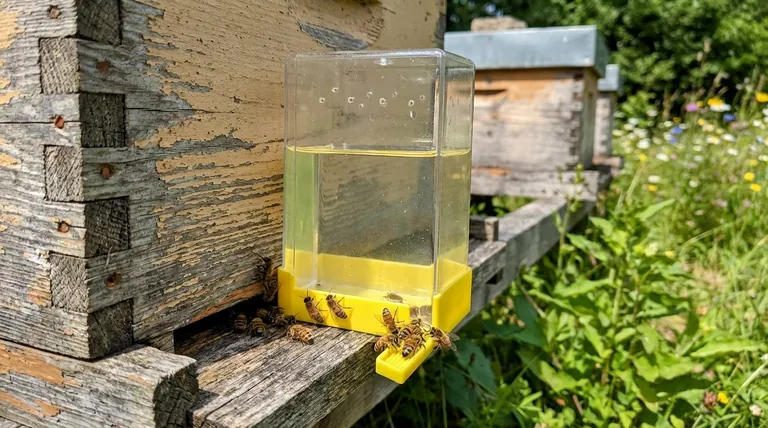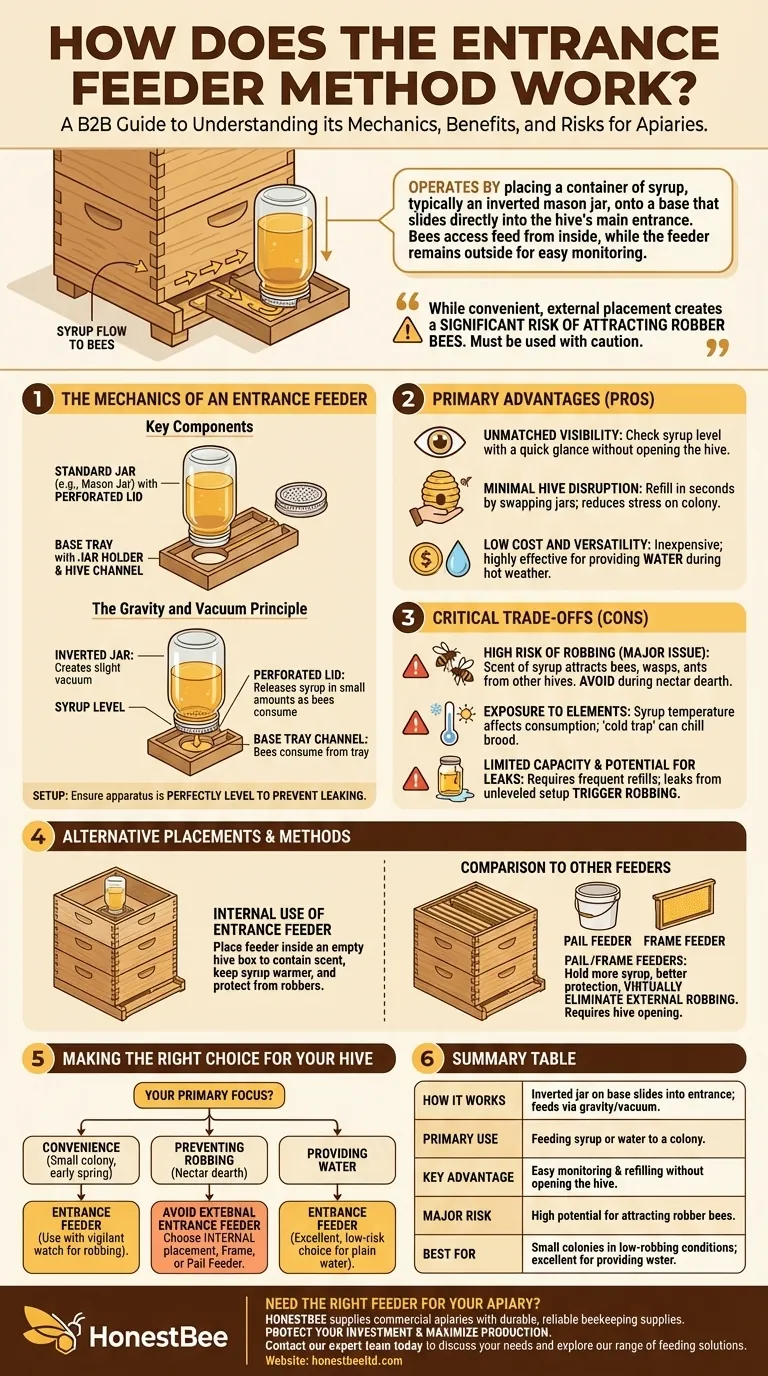An entrance feeder operates by placing a container of syrup, typically an inverted mason jar, onto a base that slides directly into the hive's main entrance. The bees can access the feed from inside the hive through a channel in the base, while the bulk of the feeder remains outside. This design allows for easy monitoring and refilling without disturbing the colony.
While entrance feeders offer exceptional convenience for the beekeeper, their external placement creates a significant risk of attracting robber bees. This critical trade-off means they are only suitable for specific situations and must be used with caution.

The Mechanics of an Entrance Feeder
To use this method effectively, it's essential to understand its simple but specific design principles. The most common model is the Boardman entrance feeder.
Key Components
The feeder consists of two primary parts: a standard jar (like a mason jar) with small holes punched in the lid, and a plastic or wooden base tray. The tray has a section that holds the inverted jar and a channel that extends into the hive.
The Gravity and Vacuum Principle
When you fill the jar with syrup and invert it onto the base, a slight vacuum is created, which prevents the liquid from rushing out. Bees consume the syrup from the tray, and as they do, small amounts are released from the jar's perforated lid to replenish the supply.
Setup and Placement
To set up an entrance feeder, you fill the jar with syrup and securely screw on the lid. You then invert the jar and place it onto the feeder base before sliding the base into the hive's entrance. It is critical to ensure the entire apparatus is perfectly level to prevent leaking.
The Primary Advantages of This Method
The enduring popularity of entrance feeders, especially among new beekeepers, is due to a few clear benefits.
Unmatched Visibility
Because the clear feed jar sits outside the hive, you can check the syrup level with a quick glance. This tells you exactly how much your bees are consuming without needing to open the hive.
Minimal Hive Disruption
Refilling the feeder is a simple process of swapping out the empty jar for a full one. This can be done in seconds without wearing full bee gear or disturbing the colony's internal activity, which reduces stress on the bees.
Low Cost and Versatility
Entrance feeders are among the cheapest feeding options available. They are also highly effective for providing a colony with water during hot weather, a task which does not carry the same risks as feeding syrup.
Understanding the Critical Trade-offs
The convenience of an entrance feeder comes with significant risks that every beekeeper must weigh carefully.
The High Risk of Robbing
This is the single greatest disadvantage. The feeder's external placement and potential for small drips can broadcast the smell of sugar syrup, attracting bees, wasps, and ants from other nearby hives. A robbing frenzy can quickly overwhelm and destroy a weaker colony. For this reason, entrance feeders should never be used during a nectar dearth or when robbing pressure is high.
Exposure to the Elements
The syrup inside an entrance feeder is exposed to ambient temperatures. On cold days, the syrup can become too cold for bees to consume easily. This can create a "cold trap" near the entrance, potentially chilling the brood.
Limited Capacity and Potential for Leaks
Compared to other feeder types, the small jar has a limited capacity, requiring frequent refills for a large, hungry colony. Furthermore, if the hive or feeder is not perfectly level, the vacuum can fail, causing syrup to leak out and immediately trigger a robbing incident.
Alternative Placements and Methods
Understanding alternatives provides context for when an entrance feeder is—and is not—the right tool for the job.
Using an Entrance Feeder Internally
You can mitigate the primary risk of robbing by using the same Boardman feeder inside the hive. To do this, place an empty hive box (super) on top of the inner cover, put the feeder over the inner cover's hole, and then replace the outer cover. This contains the scent, keeps the syrup warmer, and protects it from robbers.
Comparison to Other Feeder Types
Feeders like pail feeders or frame feeders are placed entirely inside the hive. They hold more syrup, are better protected from the elements, and virtually eliminate the risk of external robbing. While they require opening the hive to refill, they are considered a much safer option for supplemental feeding in most circumstances.
Making the Right Choice for Your Hive
Your decision should be based on your colony's specific needs and the current environmental conditions.
- If your primary focus is convenience for a small colony in early spring: An entrance feeder can be a simple starting point, but you must watch vigilantly for any signs of robbing.
- If your primary focus is preventing robbing during a nectar dearth: You must avoid entrance feeders for syrup and instead choose an internal option like a frame feeder, pail feeder, or placing your Boardman feeder inside the hive.
- If your primary focus is providing water: An entrance feeder is an excellent, low-cost choice, as plain water does not attract robbers and poses no risk to the hive.
Choosing the right feeder requires balancing convenience against the fundamental need to protect your colony from external threats.
Summary Table:
| Feature | Details |
|---|---|
| How It Works | Inverted jar on a base slides into hive entrance; feeds via gravity/vacuum. |
| Primary Use | Feeding syrup or water to a colony. |
| Key Advantage | Easy monitoring and refilling without opening the hive. |
| Major Risk | High potential for attracting robber bees. |
| Best For | Small colonies in low-robbing conditions; excellent for providing water. |
Need the Right Feeder for Your Apiary?
Choosing the correct feeding equipment is crucial for colony health and productivity. At HONESTBEE, we supply commercial apiaries and beekeeping equipment distributors with durable, reliable beekeeping supplies through our wholesale-focused operations.
Let us help you protect your investment and maximize your honey production. Contact our expert team today to discuss your specific needs and explore our range of feeding solutions and other essential equipment.
Visual Guide

Related Products
- Professional Hive Front Entrance Bee Feeder
- HONESTBEE Entrance Bee Feeder Professional Hive Nutrition Solution for Beekeeping
- Boardman Entrance Bee Feeder Durable Galvanized Steel and Wood Construction for Beekeeping
- HONESTBEE Entrance Bee Feeder Efficient Hive Front Liquid Feeding Solution for Beekeeping
- HONESTBEE Professional Entrance Bee Feeder Hive Nutrition Solution
People Also Ask
- How does an entrance feeder work? A Guide to Its Simple Mechanics and Risks
- How do you make an entrance feeder for bees? A Guide to Safe & Effective Hive Feeding
- What is an entrance feeder and how is it used? Avoid the Critical Risk of Robbing
- Are entrance feeders good for bees? Prioritize Hive Health Over Convenience
- What is an entrance feeder? A Guide to Its Simple Design and High Robbing Risk



















